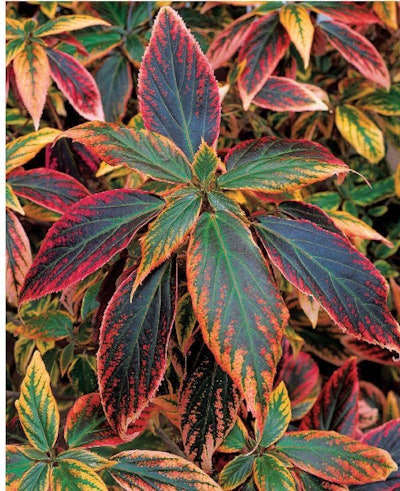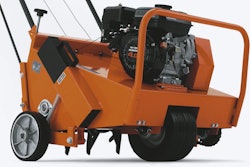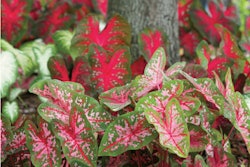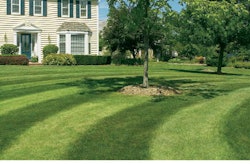Freshen up late-season landscapes with color.
 Copper plant
Copper plantWho said that maples, mums, and pansies should have all the glory in autumn? There are plenty of other fall flowers, fruits and foliage that offer a brilliant array of color during this time of year.
If you’re looking for the perfect foils to freshen up the late-season landscape, combine these autumnal-colored annuals, season-extending perennials, and evergreens or ornamental grasses with existing plantings.
‘Black Pearl’Annuals
1) Ornamental pepper (Capsicum annuum). No plant proclaims the autumn season like the colorful orange, red and purple fruits of ornamental peppers. ‘Black Pearl’ has quickly become a stand-out favorite for its shiny, almost black foliage accented by dark purple to scarlet red, berrylike peppers. Though ‘Purple Flash’ produces smaller dark purple to orange peppers, the tricolor combination of its dark purple, lavender, and white foliage is what makes this plant glow along the front of a flower bed.
Design Tip: If you’re looking to tone down the typical fall colors, pair ‘Purple Flash’ with white- or lavender-flowering summer snapdragon (Angelonia), African daisy (Osteospermum) or Viola.
2) Copper plant (Acalypha wilkesiana). A quintessential foliage plant for fall color, copper plant features brilliant leaf variations of salmon pink, orange-red and bronze. Cultivars offer wide leaves like ‘Beyond Paradise,’ narrow dissected leaves such as ‘Sizzle Scissors,’ large curled leaves like ‘Ceylon’ and oblong-shaped leaves such as ‘Bourbon Street.’ Copper plant grows to about 2 to 3 feet tall.
Design Tip: Combine copper plant with a border of sweet potato vine for maximum impact, and then place pumpkins and squash of assorted sizes into the sweet potato vine for added interest.
3) Firebush (Hamelia patens). Considered a perennial or shrub in warmer climates, firebush can also be used as a mid-sized annual. Clusters of tubular orange-red flowers adorn 3-foot-tall plants. During summer, it is valued for its heat and drought tolerance. As temperatures cool down, the light green foliage turns reddish orange, which can be enjoyed until frost. ‘Sierra Red’ is a red-flowering form that blooms from spring until frost.
Design Tip: Play the bright oranges and reds of firebush off the multi-colored foliage of the tropical croton.
Perennials
False aster4) Drakensberg Daisy (Gerbera ‘Drakensberg’ series). Push the hardiness zones with this resilient new Gerber daisy. Bred from an alpine plant found in the mountains of South Africa, the Drakensberg daisy demonstrates a tremendous range of heat and cold tolerance and won’t stop blooming or die back until a hard frost. The classic, 2-inch Gerber daisy flowers come in a variety of colors, including white, pink, orange and red. Hardy in USDA Zones (7) 8 to 11.
Design Tip: Combine the different flower colors of the Drakensberg series for a remarkable show.
5) False Aster (Boltonia asteroides). A lesser-used alternative to mums and asters, this low-maintenance perennial is a perfect addition to the middle or back of a perennial border. Profuse white, daisy-like flowers form on 4-foot-tall plants and last from late summer until after frost. Try ‘Jim Crockett’ with its pale lavender blooms on 2-foot-tall plants. Hardy in USDA Zones 4 to 9.
Design Tip: For a cool-season color scheme for a perennial border, plant ‘Jim Crockett’ with lamb’s ear (Stachys byzantina ‘Helene Von Stein’), Aster, blue lyme grass (Elymus arenarius), wormwood (Artemisia x ‘Powis Castle’) and switch grass (Panicum virgatum ‘Heavy Metal’).
6) Perennial Spurge (Euphorbia). Though their bright-green flowers are enjoyed in spring, the evergreen foliage of many perennial spurges holds their own in late fall to winter. With the cooler temperatures, ‘Rudolph’ (E. x martinii ‘Waleuphrud’) develops a red “nose” at the end of each stem, contrasting nicely with its dark green foliage. The striking variegated foliage of ‘Tasmanian Tiger’ (E. characias ‘Tasmanian Tiger’) holds its green and creamy white coloration through winter. Both grow to about 2 feet tall and about as wide. Hardy in USDA Zones 6 to 9 (10).
Design Tip: For containers with cool season interest, combine ‘Rudolph’ with red-flowering pansies, ‘Caramel’ heuchera and ‘Toffee Twist’ carex.
Ornamental grasses
7) Marc Anthony Variegated Liriope (Liriope muscari ‘Marant’). Not your run-of-the-mill monkey grass, the yellow-green striped foliage of this tough evergreen groundcover retains its full variegation all season long. Plus, it doesn’t scorch in full sun. Hardy in USDA Zones 5 to 9.
Design Tip: Use it along the front border of a mass planting of fall-blooming annuals, like pansies and snapdragons, in contrasting colors. Change out annual plantings from season to season while Marc Anthony remains the same.
8) Variegated Japanese Sedge (Carex morrowii). This mounding evergreen perennial looks good all summer but thrives during the cool season. The narrow, creamy-white and green leaf blades offer a fine texture to the landscape. Plant this 1-foot-tall sedge along the border in part shade to full sun. Hardy in USDA Zones 5 to 9.
Design Tip: Plant a mass of variegated Japanese sedge in light shade and then interplant clumps of fall-blooming, white-flowering perennial, Anemone ‘Honorine Jobert.’
Switch grass9) Switch grass (Panicum virgatum). This striking, upright grass has green to blue-green foliage that turns reddish purple and produces an array of airy purplish flower spikes in cooler temperatures. Switch grass holds up well during winter when it can be heard swishing in the landscape. Try out popular selections like ‘Northwind’ or ‘Heavy Metal’ that reach about 6 feet tall, or newer, shorter options such as the 4-foot ‘Dust Devil’ or ‘Cheyenne Sky,’ whose reddish foliage grows to just 3 feet tall. Hardy in USDA Zones 4 to 9.
Design Tip: Create a prairie look by combining the various textures of several fall-blooming ornamental grasses, such as switch grass, maiden grass (Miscanthus), muhly grass (Muhlenbergia), and feather reed grass (Calamagrostis). Interplant this display with Joe Pye weed (Eupatorium purpureum), coneflower (Echinacea) and black-eyed Susan (Rudbeckia).
EDITOR’S NOTE: This article was written by Susan Morgan.










